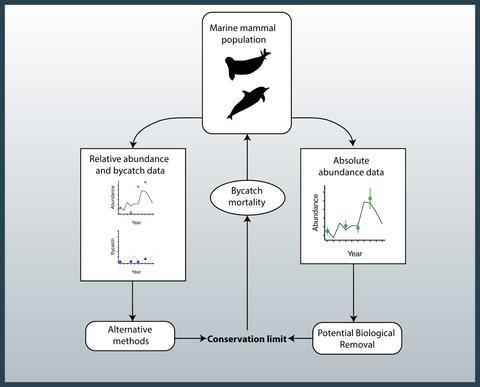当前位置:
X-MOL 学术
›
J. Appl. Ecol.
›
论文详情
Our official English website, www.x-mol.net, welcomes your
feedback! (Note: you will need to create a separate account there.)
Can we manage marine mammal bycatch effectively in low‐data environments?
Journal of Applied Ecology ( IF 5.0 ) Pub Date : 2020-12-10 , DOI: 10.1111/1365-2664.13816 André E. Punt 1 , Margaret C. Siple 1 , Tessa B. Francis 1, 2 , Philip S. Hammond 3 , Dennis Heinemann 4 , Kristy J. Long 5 , Jeff Moore 6 , Maritza Sepúlveda 7 , Randall R. Reeves 8 , Guðjón Már Sigurðsson 9 , Gísli Víkingsson 9 , Paul R. Wade 10 , Rob Williams 11 , Alexandre N. Zerbini 10, 12, 13
中文翻译:

我们可以在低数据环境中有效地管理海洋哺乳动物兼捕吗?
更新日期:2020-12-10
Journal of Applied Ecology ( IF 5.0 ) Pub Date : 2020-12-10 , DOI: 10.1111/1365-2664.13816 André E. Punt 1 , Margaret C. Siple 1 , Tessa B. Francis 1, 2 , Philip S. Hammond 3 , Dennis Heinemann 4 , Kristy J. Long 5 , Jeff Moore 6 , Maritza Sepúlveda 7 , Randall R. Reeves 8 , Guðjón Már Sigurðsson 9 , Gísli Víkingsson 9 , Paul R. Wade 10 , Rob Williams 11 , Alexandre N. Zerbini 10, 12, 13
Affiliation

|
- Determining acceptable rates of human‐caused mortality in low‐data situations is a concern for many taxa world‐wide. An established approach for determining acceptable levels of human‐caused mortality of marine mammals and other species of conservation concern is the Potential Biological Removal (PBR) framework, but PBR requires near‐unbiased estimates of absolute abundance, constraining its use in systems with limited data.
- We develop three alternative methods for identifying acceptable levels of human‐caused mortality for long‐lived, slowly reproducing species, using indices of relative abundance combined with estimates of bycatch mortality in fisheries, and evaluate these methods using simulations similar to those used to develop PBR.
- Across a variety of scenarios, the parameters of the three methods can be tuned to achieve conservation performance similar to that of PBR in scenarios that represent nearly ideal conditions. However, these methods produce lower and more variable bycatch mortality limits, depend upon reasonably accurate estimates of bycatch mortality and are more sensitive to uncertainties.
- Synthesis and applications. Here we develop three alternative methods that expand the toolbox of approaches available for use in determining marine mammal conservation reference points for human‐caused mortality when it is not possible to apply the more standard, data‐hungry PBR approach. These approaches may be useful in supporting the establishment of new bycatch management programmes, or until estimates of absolute abundance become available.
中文翻译:

我们可以在低数据环境中有效地管理海洋哺乳动物兼捕吗?
- 在全球范围内,确定低数据情况下人为造成的死亡率的可接受比率是一个令人担忧的问题。潜在的生物清除(PBR)框架是确定人为造成的海洋哺乳动物和其他保护物种死亡率的可接受水平的公认方法,但是PBR需要绝对丰度的近似估计值,从而限制了其在数据有限的系统中的使用。
- 我们使用相对丰度指数并结合渔业中兼捕物死亡率的估算,开发了三种方法来确定长期存在,缓慢繁殖的物种的人为造成的死亡率的可接受水平,并使用与开发PBR相似的模拟方法评估这些方法。
- 在各种情况下,可以对这三种方法的参数进行调整,以实现与代表近似理想条件的情况下的PBR相似的保护性能。但是,这些方法产生的兼捕死亡率较低且变化较大,取决于兼捕死亡率的合理准确估计,并且对不确定性更加敏感。
- 综合与应用。在这里,我们开发了三种替代方法,这些方法扩展了无法用于确定人为致死性海洋哺乳动物保护参考点的方法的工具箱,而这可能无法应用更标准,数据饥渴的PBR方法。这些方法可能有助于支持新的兼捕管理计划的建立,或者直到获得绝对丰度的估计值为止。











































 京公网安备 11010802027423号
京公网安备 11010802027423号